SHARP-EATMAN
NATURE
PHOTOGRAPHY
ID GUIDE TO WILD BEES - NEW YORK

LONG-HORNED BEES
Genus Melissodes
LONG-HORNED BEES belong to the tribe Eucerini and have unusually long antennae – hence the name long-horned. Eucerini serve as essential pollinators for multi-million-dollar crop industries. They include, among others, Peponapis squash bees, key pollinators of melons and squash; and Svastra sunflower bees, instrumental in sunflower production. The tribe Eucerini also includes Melissodes long-horned bees, a genus of irreplaceable pollinators of garden flowers, native wildflowers and sunflower crops.
Melissodes females are robust, medium-sized bees with hairy heads and bodies and plushly-haired hind legs. Males generally are slenderer and have much longer antennae than females; males look a little like furry Chinese dragons. Males and females often have striking green or blue-gray eyes. In our area, Melissodes long-horned bees tend to emerge in the mornings and early afternoons during July and August.
All Melissodes are ground-nesters. They bees carve holes in the earth, where they construct individual nests containing brood cells lined with a waxlike material, each typically holding one egg and a single pollen ball. The nests, which may be isolated or built in groups, are often hidden under brush. Thus, Melissodes long-horned bees are most easily spotted while away from their nests, foraging for nectar and pollen.
The genus Melissodes is represented by several different subgenera within the United States. Three of these are found in Rockefeller State Park and Stone Barns Center for Food and Agriculture - Eumelissodes, Heliomelissodes and Melissodes. Six distinct species representing these subgenera are found below.

This Stone Barns garden is an excellent example of a flower assortment likely to attract long-horned bee pollinators. The garden contains multiple species of the plant family Asteraceae, including coneflowers, rudbeckia, sunflowers and pink strawflowers.

This is a female true long-horned bee (possibly M. subillata). Females have shorter antennae than males and carry pollen on long scopae (sticky hairs) on their legs. This bee is gathering pollen from black-eyed Susans in Stone Barns' flower garden in mid-July.

This female true long-horned bee has blue-gray eyes, and grayish coloring resulting from pale hairs intermixed with some dark hairs.
At Stone Barns Center for Food and Agriculture, two varieties of specialist long-horned bees can be found energetically visiting sunflowers in the vegetable fields during July and August: Melissodes trinodis and Melissodes agilis.
Sunflowers are particularly attractive nectar and pollen sources for bees. A sunflower is actually a collection of tiny flowers -- each sunflower blossom consists of many tightly-packed tubular florets filled with pollen and nectar. A single sunflower may have thousands of florets. This structure allows bees to move efficiently from one pollen source to another without between-flower flights. The broad landing pad of a sunflower also provides a place where bees can rest between pollen-gathering stints.
Melissodes trinodis,or the dark-veined long-horned bee, is a robust bee with a thorax covered with light-brown or rust-colored hairs. Females have gray-blue eyes and thick scopal hairs on their hind legs. Males green eyes, long antennae, a yellow or pale clypeus (the facial part above the bee's mandibles); and (usually) yellow or pale spots on the bases of their mandibles.
Typically, females of this species appear on sunflowers with the scopae of their back legs heavily laden with yellow pollen. At Stone Barns, during July and August, they often commingle in groups of several female bees spread across the large surface of a single sunflower. Males can be found flying rapidly from one sunflower to the next, patrolling for mates, and rarely alighting in one place for long.
Melissodes trinodis at Stone Barns are found nearly exclusively on sunflowers, but they also can be found visiting black-eyed Susans, coneflowers, pumpkins, and squash.
Melissodes trinodis is very similar to Melissodes agailis, and the two species may be difficult to tell apart without the help of an expert. Dark-veined long-horned bees generally run somewhat smaller; they frequently have a rust-colored cast to their thorax hairs; their wing veins are darker than those of agile long-horned bees; the rims of the upper abdominal (tergal) segments of Melissodes trinodis are a dark transparent brown, while those of M. agilis are clear; the abdominal bands of M. trinodis may have an orange tint; and the mandible coloration and size of antennal segments differ slightly in males of the two species.
Melissodes agilis, or the agile long-horned bee, is somewhat less common than the dark-veined long-horned bee at the park and Stone Barns. The agile long-horned bee has a thorax covered with hairs, and an abdomen banded above by pale hairs. Its thorax hairs tend to be entirely pale or blondish rather than rust-colored. The hair on the bee's vertex (behind the compound eyes) is also usually entirely pale.
Female Melissodes agilis have blue eyes, and males have green eyes and long reddish antennae. According to entomologist Charles D. Michener, Melissodes agilis females have especially feathery hairs on their hind legs. Males (like Melissodes trinodis males) typically have either a white or pale-yellow clypeus, sometimes with a narrow brown edge around it. The bases of the male bees' mandibles are also marked with yellow.
Although at Stone Barns agile long-horned bees have been documented exclusively on cultivated sunflowers, these bees are also documented pollinators of other members of the Asteraceae family such as chrysanthemums , blanketflower and gumweed.
A female Melissodes (Eumelissodes) on rudbeckia

Sunflower Pollinators:
The Dark-veined long-horned bee
and the Agile long-horned bee
Melissodes trinodis & Melissodes agilis
Subgenus Eumelissodes
1/3" - 3/5" (medium-sized)
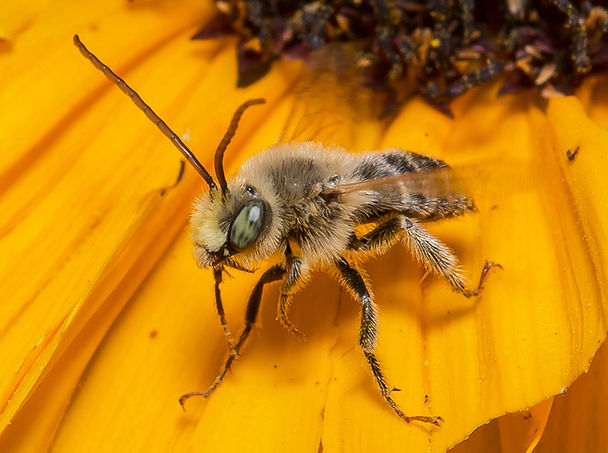
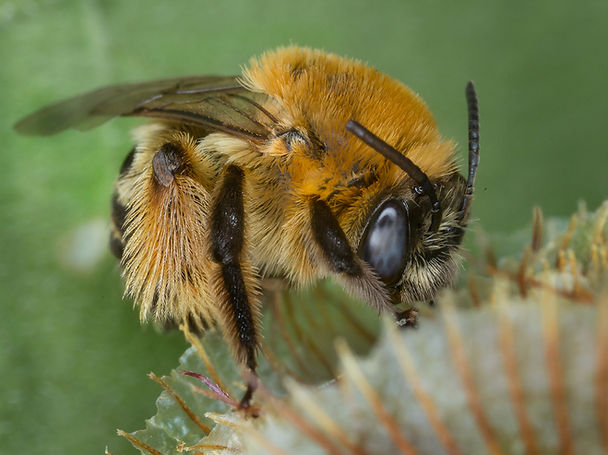
A female Melissodes trinodis

A female Melissodes trinodis on a sunflower

This is a female Melissodes trinodis. The thorax hair of this species is often rust-colored as shown here.

Female Melissodes trinodis have shorter antennae than males and bushy scopal hairs on their legs.
True Long-horned Bees
Melissodes Subgenus Eumelissodes spp.
1/3" - 3/5" (medium-sized)
Eumelissodes or True Long-horned Bees: The largest subgenera of New York's Melissodes is Eumelissodes, sometimes referred to by the common name “true long-horned bees”.
Most Melissodes (Eumelissodes) are about the size of a honey bee, or slightly smaller or slightly larger. They have hairy faces and thoraxes (mid-sections), and their abdomens are typically dark and striped with pale bands of hair. Males have long antennae or “horns," while the females have short antennae. Females have long pollen-collecting (scopal) hairs on their hind legs. As is typical of bees generally, males sip nectar from flowers but do not gather pollen and hence lack scopae.
In The Bees of the World, entomologist Charles D. Michener notes two distinguishing traits of Eumelissodes, both of which are linked to gender. The scopal hairs of female Melissodes (Eumelissodes) are feathery, as shown on the bee at top right. The clypeus of male true long-horned bees is distinctively yellow or pale, as shown in the photoshtrip below. (The clypeus is the face part above the bee's mandibles.)
The Melissodes (Eumelissodes) shown at right are fairly representative of their subgenus -- robust and hairy, with banded abdomens. All are between 1/3" and 1/2" in length. Individual species
of Melissodes (Eumelissodes) vary in the color of their wings, hair, eyes, legs and antennae. The bees here, for example, have hair that runs from white to pale brown to grayish; their eyes range from green to gray to blue-gray; and the antennae of the top two are black, while those of the last bee are reddish-brown.
There are many species of Melissodes (Eumelissodes) in the park and Stone Barns and at least 11 documented species in New York State. Four are represented directly below on this guide page: Melissodes agilis, Melissodes trinodis, Melissodes denticulata and Melissodes subillata.
Taxonomy of Melissodes Long-horned Bees
Order: Hymenoptera
Family: Apidae
Subfamily: Eucerinae
Tribe: Eucerini (Long-horned Bees)
Genus: Melissodes
Subgenus: Eumelissodes
Long-horned Bees and Pollinator-attracting Plants:
Melissodes (Eumelissode) may be either generalist pollinators that feed on a range of flowering plants, or specialists that focus on particular plant varieties. Many favor flowers within the Asteracae family (also known as composites). These include, among others, sunflowers, coneflowers, zinnias, rudbeckia, goldenrod, dahlias, strawflowers, cosmos, chamomile, thistles, ironweed and purple asters.
The flower gardens at Stone Barns Center for Food and Agriculture are particularly well-suited for sustaining a diversity of Melissodes (Eumelissodes), because the gardens contain multiple flowering plant species of the Asteracae family. Part of Stone Barns' principal flower garden is shown in the photostrip here.

A male Melissodes (Eumelissodes) on a coneflower
A male Melissodes agilis
Melissodes denticulatus is found at the park in late summer. This bee is a specialist pollinator that prefers feeding on Ironweed (Vernonia), a plant with deep purple flowers, native to New York, that blooms in August. Ironweed belongs to the botanical family Asteraceae, the plant group most frequently visited by Melissodes bees.
Many of the bees shown here were found gathering nectar from a native species of ironweed that grows as tall as nine feet high, known as giant ironweed (Vernonia gigantea). Despite the fact that Melissodes denticulatus feed almost exclusively on ironweed, they have been documented elsewhere foraging on other flora, such as rudbeckia, centauraea, goldenrod, penstamon, veronica and cucurbits. In July and August of 2016, and 2017, Melissodes denticulatus long-horned bees appeared in large numbers feeding on coneflowers in the Visitor's Center garden of Rockefeller State Park Preserve.
Identification information: This long-horned bee is very fast and tends to alight only briefly on blossoms. When viewed from afar or in flight, Melissodes denticulatus bees have an overall grayish cast. Viewed more minutely, they have a robust shape; a black thorax covered with pale grayish-brown hairs; a black abdomen striped with pale hair bands; transparent brown wings with dark veins; and striking bluish-gray eyes. The bees shown here were relatively small for long-horned bees, rarely appearing more than 1/3" in length.
Female Melissodes denticulatus have bushy pale scopal hairs on their back legs. Males have long reddish antennae. The clypeus of the male bee is distinctive: is a ceamy white with a dark strip on the bottom, and a jagged dark top edge (shown in the photo strip here). In addition, it is notable that males as well as females of this species have blue-gray eyes. This trait helps distinguish them in the field, since most other male Melissodes (Eumelissodes) of our area have green eyes.
A note on similar species that feed on ironweed: Melissodes denticulatus is the single northeastern long-horned bee species that specializes in pollinating ironweed. A second long-horned bee that is a specialist feeder on ironweed exists in the midwestern and southern United States -- Melissodes vernoniae. Images of a live specimen of that bee unfortunately are not available on central web databases such as bug.guide.net and Discover life. Melissodes vernoniae is larger than M. denticulatus and its wings, legs and mandibles have a rust-red tint. It also belongs to the subgenus Eumelissodes. The thistle long-horned bee and Melissodes subillata shown below also feed occasionally on ironweed.
Ironweed Long-horned Bee
Melissodes denticulatus
Subgenus Eumelissodes
1/3" - 2/5" (medium-sized)
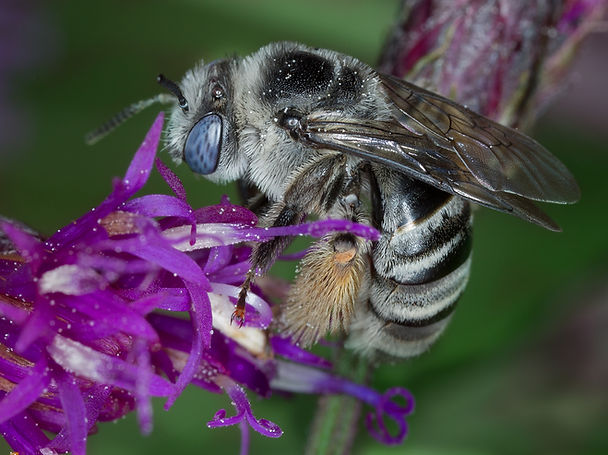
Melissodes denticulatus (female)
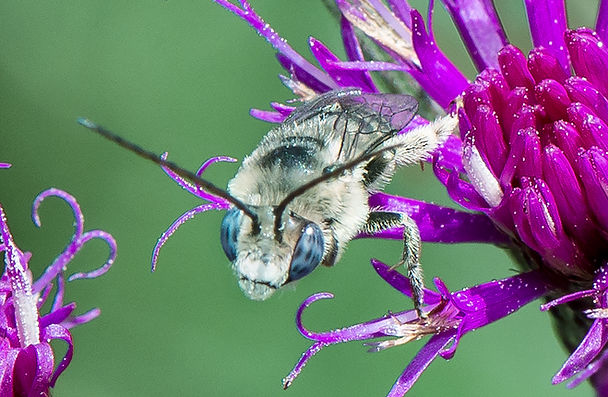
Melissodes denticulatus (male)
All photos (c) 2014 - 2024 Sharp-Eatman Nature Photography
Melissodes Subillata Long-horned Bee
Melissodes subillatus
Subgenus Eumelissodes
1/3" - 1/2" (medium-sized)
Of all the bees in this guide, this one seems the most obscure: little has been written about its appearance or biology. Even the bee's name seems intended to relegate it to the barely-worth-mentioning status: subillatus means "imperfectly illatus" or "not really quite illata," a reference to another, earlier-discovered long-horned bee called Melissodes illatus.
This is unfortunate because this is a stunning bee. Males have extravagantly long reddish antennae, yellow masks on their faces and smoky-blue eyes. The male Melissodes subillata shown here was sleeping while hanging in a daredevil way from its mandibles on a flower stem.
Like other long-horned bees of the subgenus Eumelissodes shown on this page, Melissodes subillatus are principally pollinators of plants in the Asteraceae family. The male bee shown here was gathering nectar from coreopsis.
Melissodes subillatus females have been recorded pollinating a range of flowering Asteraceae -- including black-eyed Susans; blanketflowers; blazing star; cornflowers; the hardscrabble perwinkle-blue chicory flower that grows along New York roadsides (Lactuca pulchella); chrysanthemums and asters; coneflowers; dandelions; Joe Pye weed; goldenrod; hawkweed; ironweed; and sunflowers. Melissodes subillata also have been documented pollinating a narrow range of plants outside of the Asteracaea family, including bellflowers, bindweed, germanders, milkweed and thistles.
Identification information: The male bee shown here was small as long-horned bees go, barely 1/3" (not including its antennae). Males and females of this species, however, may be as long as 1/2 inch. The male bee shown in the photo strip here has a hairy head and thorax and an abdomen striped with bands of long pale hairs. Its clypeus is yellow, and its mandibles dark with small spots of yellow near the base. Dark and light hairs commingle on the bee's thorax.
The presence of both light and dark hairs on the bee's vertex (behind the compound eyes) is a distinctive trait of male Melissodes subillatus that aids in their identification. This species can be distinguished in part from Melissodes illatus by minute traits relating to hair patterns on the abdomen: on Melissodes subillataus, the hairs on the base of the second segment (T2) are pale rather than dark.
Females of this species have robust bodies, banded abdomens and bushy pale hairs on their hind legs. Like the males, the females have blue-gray eyes. They have shorter antennae than the males and lack the yellow clypeus.
This is the single specimen of this species documented at the park or Stone Barns. Its range extends north to Saskatchewan and south to North Carolina.
Additional Web photographs of this species can be found at the Packer Lab's website featuring a key to the bees of Canada.

Melissodes subillatus (male)
All photos (c) 2014 - 2016 Sharp-Eatman Nature Photography

A male Melissodes subillatus: this bee has blue-grey eyes, reddish antenna, a hairy thorax and a banded abdomen.

A male Melissodes subillata sleeping while clinging to a stem with its jaws. Such behavior is typical of male long-horned bees generally.

The male Melissodes subillata has a yellow clypeus.

A female Melissodes denticulatus

A female bee pollinating ironweed. Female Melissodes denticulatus have bushy pale scopal hairs on their hind legs.

Shown here are the distinctive stripes (formed by pale hairs) on the abdomen of a female Melissodes denticulatus. Note that a "notch" of black hair interrupts the fourth white band on the bee's abdomen.
Thistle Long-horned Bee
Melissodes desponsus
Subgenus Heliomelissodes
2/5" - 5/8" (medium-sized)
All of the long-horned bees shown above belong to the subgenus Eumelissodes, The thistle long-horned bee, however, belongs to a different group -- the small subgenus Heliomelissodes, which has only two bee members worldwide, and only one in the northeastern United States. According to entomologist Charles D. Michener, bees of this subgenuscan be recognized by the distinctive qualities of their faces. On Heliomelissodes, the clypeus (the face above itthe mandibles) is protuberant; and the labrum (situated under the clypeus) is entirely black. These traits are shown n the photo strip here.
Melissodes desponsus are oligoletic, specializing principally on thistles, which belong to the plant family Asteracae. The bees' dependence on thistles makes their continued existence in some environments precarious. Other efficient pollinators, such as bumble bees and honey bees, also forage on thistles and may compete for their pollen and nectar. In many parts of New York, thistles bloom in August, a month when droughts are common and when alternate pollen sources dry up. Thus, competition among bee species may be particularly fierce during the period when thistle long-horns are feeding. Without an abundance of thistles in a habitat, thistle long-horned bees may struggle for survival.
Thistle long-horned bees forage at times on other plants. The bees shown here were found feeding on thistles, and on ironweed (a similarly-colored aster-family plant). Thistle long-horned bees also feed on composites such as blanket flower and goldenrod.
The nests of these long-horn bees are parasitized by the Triepeolus donatus cuckoo bee.
Identification information: Female Melissodes desponsus have have robust bodies, black abdomens and thick pale yellow-brown hair covering their thoraxes. They are sometimes mistken in the field for bumble bees. Female Melissodes desponsus however, can be distinguished from the latter by the bushy, pale-gold scopal hairs on their hind legs.
The legs of male thistle long-horned bees are covered entirely with black hairs -- a trait shared by bumble bee species of our area. Male thistle long-horned bees, nonetheless, have yellow clypei and very long antennae, characteristics that distinguish them easily from bumble bees.
Taxonomy of Thistle Long-horned Bees
Order: Hymenoptera
Family: Apidae
Subfamily: Apinae
Tribe: Eucerini (Long-horned Bees)
Genus: Melissodes
Subgenus: Heliomelissodes
Species: Melissodes desponsaa

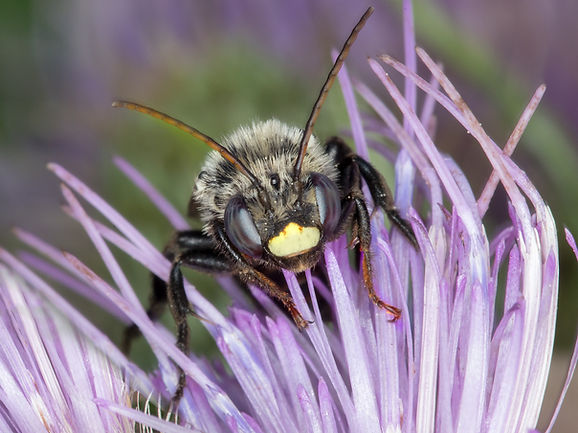
Melissodes desponsus (male)
All photos (c) 2014 - 2016 Sharp-Eatman Nature Photography

A female thistle long-horned bee

Female thistle long-horned bee have copious pale-gold scopal hairs on their hind legs, used to carry pollen

Note the protuberant clypeus of the female bee. The female's clypeus is black.
Two-spotted Long-horned Bee
Melissodes bimaculatus
Subgenus Melissodes
43 - .55 inches (Medium-sized)
Melissodes bimaculatus, or two spotted long-horned bee, belongs to the subgenus Melissodes -- a different subgenus than any of the other long-horned bees shown on this guide page. Unlike the Eumelissodes and Heliomelissodes featured above, which prefer pollinating plants of the Asteraceae family, two-spotted long-horned bees are generalist pollinators that forage on a range of plants.
Identification information: These beautiful bees are coal-black -- so dark that on sunny days, it is difficult to discern more than the bees' dark silhouettes when they land on brightly-colored flowers. On closer inspection, you will see that Melissodes bimaculataus have black wings, dark antennae and dark blue-gray eyes. Females have hind legs adorned with ostentatious, feathery, pale hairs, often heavily laden with pollen. Their other legs are black and covered with thick dark hair.
The name "two-spotted longhorn" comes from the fact that the female bees have two pale spots on the tips of their abdomens (as shown in the photo strip here). Males lack the spots. On males, the clypeus (the face part above the mandibles) and the labrum (the lower part of the face, between the mandibles) are yellowish-white. Male bees have long reddish antennae, and reddish lower legs and feet. Their hind legs are mostly dark, and partly-covered with pale hairs (a trait that helps distinguish them from the dark male thistle long-horned bee shown above, which has entirely dark legs).
Two-spotted long-horned bees are solitary ground-nesters. They are industrious foragers, often the first to arrive on blossoms in the morning. They are considered one of the three most important pollinators of cotton. (The other two are honey bees and common eastern bumble bees.) They are also significant pollinators of pumpkins, cucumbers and watermelons, and are reportedly more efficient pollinators of watermelon than honey bees.
Two-spotted long-horned bees are important pollinators of hardscrabble wildflowers such as bugloss, dandelions, panicled-leaf ticktrefoil, thistles and the beautiful blue chicory that grows throughout the park in sunny areas. The bees pollinate many garden flowers as well, including cosmos, coneflowers, agastache and monarda.
Melissodes bimaculataus appear in pumpkin, cucumber and flower plantings of Stone Barns Center. for Food and Agriculture in late summer. The female bee shown here was found feeding in mid-August on coneflowers and zinnias in Stone Barns’ flower garden.
This species has a wide geographical distribution: it is found as far west as Idaho, as far north as Ontario and as far south as Texas and Florida.
Taxonomy of Two-Spotted- Long-horned Bees
Order: Hymenoptera
Family: Apidae
Subfamily: Apinae
Tribe: Eucerini (Long-horned Bees)
Genus: Melissodes
Subgenus: Melissodes
Species: Melissodes bimaculatus

A male Melissodes bimaculatus
All photos (c) 2014 - 2016 Sharp-Eatman Nature Photography


Females' bodies, heads and legs are covered with predominantly black hairs. Pale, bushy hairs cover their hind legs. The females' faces and antennae are black, and their eyes dark gray.

The female Melissodes bimaculatus has two pale markings on the rear of its abdomen.
Melissodes desponsus (female)
This website's photos and text are protected by registered copyright. All photos are © 2014-2018 Paula Sharp & Ross Eatman, all rights reserved. To inquire about possible use of photos, see Permissions.
REFERENCES: For a comprehensive list of references used in compiling this guide, click here:
